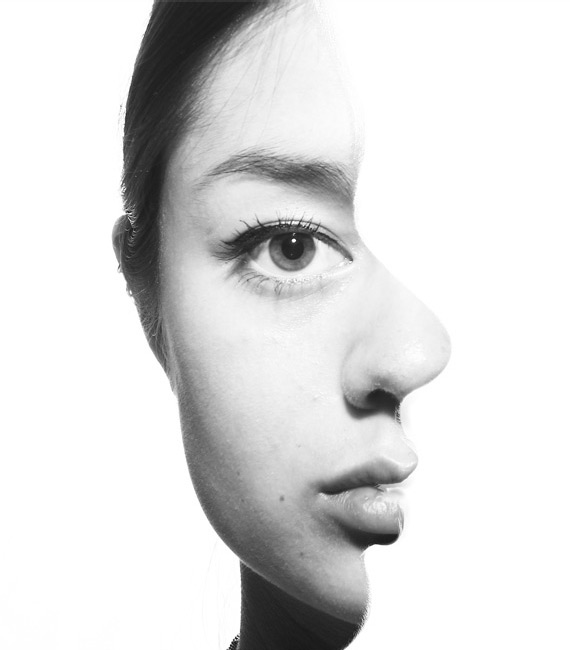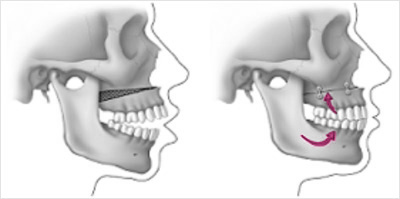Orthognathic surgery corrects misalignment of the jaw, the facial skeleton and the teeth

Orthognathic surgery is performed by a maxillofacial surgeon. It improves chewing, speaking and breathing. It also improves aesthetic and functional aspects.
Here are some examples of conditions that may indicate the need for this surgery:
- Non-functional occlusion
- Difficulty chewing
- Difficulty swallowing
- Temporo-mandibular pain, headaches, severe tooth wear
- Open occlusion or anterior open bite
- Unbalance facial appearance from front or profile
- Facial trauma
- Congenital malformation
- Receding or prominent chin
- Mouth breathing and dry mouth
- Inability to close lips without forcing muscles
- Sleep apnea
Who needs this type of surgery?
Patients whose jaws are not properly aligned, which often results from a difference in the jaws growth potential. An orthodontic treatment is generally combined to correct the alignment of the teeth, after which the surgery will correct the defective alignment of the jaws.
Patient evaluation
Your dentist, orthodontist and surgeon will work together to determine whether you are a candidate for this type of treatment. This evaluation will include x-rays, models of your teeth, specific facial measurements and photographs. You will be given a diagnosis and the stages of the treatment, their risks, benefits and alternatives will be discussed. The treatment will include a preparatory orthodontic stage (before the operation), the surgery and then the postoperative orthodontic stage. This process can easily take one or two years. The surgery may include one or both jaws and the chin. Your orthodontist and surgeon will explain the various treatment stages and estimated time involved.

Correcting an open occlusion is done by means of surgery to the upper jaw and sometimes to the lower jaw also, to allow the back teeth to chew together.

Correcting a protrusive lower jaw (protruding) consists in separating a posterior section from the anterior section (which contains the teeth). It is then placed (moved back) into the optimal position for aesthetics and function.

Correcting a retrusive jaw (too far back) and or a weak chin consists in performing a surgery on the lower jaw at the back and repositioning it with screws or wires. Surgery may be performed to change the appearance of the chin.
What about the operations?
To start with, it is essential to begin working with an orthodontist even before planning your treatment. Orthodontic appliances will be used during the preoperative stage. As the treatment progresses, patients have the impression that their dental deformity is increasing. In fact, the orthodontist is eliminating the compensation component that nature created to camouflage and reduce the impact of your malocclusion. During the surgical treatment, the position of your teeth and your profile will be optimized.
When your preparatory orthodontic stage is complete, your case will be reviewed. Models of your teeth, photographs, facial measurements and x-rays will be required in order to plan every detail of the operation.
Surgeries can be performed at our outpatient surgery centre or at a hospital. The length of the surgery depends on whether one or both jaws will be operated on and if a genioplasty (surgery to augment or reduce the chin) is required.
Your maxillofacial surgeon will reposition the maxillary bones as needed. In some cases, a bone graft may be necessary. Titanium plates and screws, metal wires or orthodontic elastics are used to hold the segments in their new position. The incisions are inside the mouth to avoid scarring. Small incisions in the skin may be necessary and their visibility is minimal. After the surgery, your surgeon will give you instructions regarding your diet. It may be liquid to begin with, then soft, and normal consistency later on. Smoking is strongly discouraged while convalescing from orthognathic surgery. It could result in incomplete healing, and further corrective surgeries may be necessary. Physical exercise is not possible during the first weeks of convalescence.
Discomfort caused by orthognathic surgery is well controlled with painkillers and patients can return to school or work within 2 to 6 weeks, depending on their treatment and tolerance. The bone takes between 9 and 12 months to heal fully.
The benefits of the surgery
This surgery optimizes the position of your teeth and jaws in order to improve function and aesthetics. The effects are highly positive with regard to chewing, facial profile and phonetics. This operation has a positive impact on several facets of your daily life.
